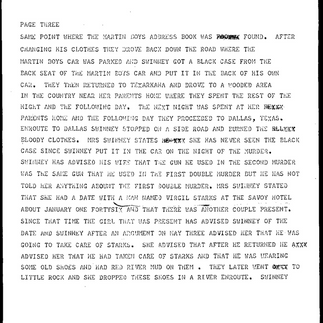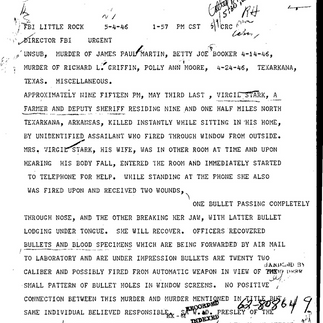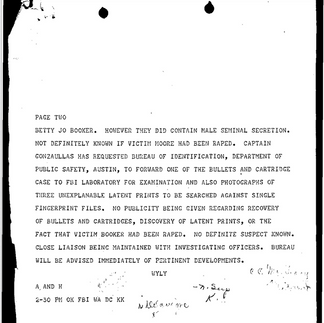Case Files: Moonlight Murders & Texarkana Phantom
- Sirens Podcast
- Nov 8, 2021
- 12 min read
Updated: Mar 16, 2022
The Moonlight Murders & The Texarkana Phantom Killer
The First Attacks: The first attack took place on February 22, 1946, on a secluded road outside of town. The Phantom approached Jimmy Hollis and Mary Jeanne Larrey, a young couple parked in their car on the side of the road only a mere 100 years from the nearest house. The had just come from the movies. He blinded them with his flashlight upon approach, then held them at gunpoint and ordered them out of the vehicle. They could see that the person was wearing a white hood/mask that looked much like a pillow case with eye holes cut out. The Phantom then told Jimmy Hollis to remove his pants and he did so. The man then hit him twice with his pistol, cracking his skull open and knocking him unconscious. Mary said that she thought he had been shot at first because the sound of the pistol hitting his skull was so loud.
Mary, thinking this was a robbery, tried to show the man Hollis’ wallet, to show him they had no money. But the man instead hit her over the head with a blunt object (possibly the gun). The Phantom then told Mary Jeanne Larrey to run. When she scrambled toward a ditch, he told her to change course and run toward the road. The attacker caught up to her and, strangely, asked her why she was running. When she answered, “Because you told me to,” he called her a liar and knocked her down. He then sexually assaulted her with the gun before letting her run away again.
Afterwards, Mary fled to a nearby house to get help. Hollis, meanwhile, had come to and flagged down a passing car for help as well. He had suffered multiple skull fractures and was in the hospital for several days.In spite of the savagery of their attacks, both Hollis and Larrey survived. When they recounted their attack to the police, there were a few inconsistencies between their stories. Hollis, who admitted he didn’t see the man very clearly, thought he was probably white, or maybe a light-skinned black man. Mary, who had been much closer to the attacker, said he was black. Seizing on these inconsistencies, the police suspected the couple wasn’t telling the truth — that they knew their attacker and were lying to protect him. The attack was chalked up to revenge. ---------------------------------------------------------------------- The 2nd Attacks: Then, early on the morning of March 24, a motorist found a car parked at the end of Rich Road, a secluded lover’s lane. Inside, he saw the bodies of 29-year-old Richard Griffin, a veteran who made his living in carpentry and painting, and his 17-year-old girlfriend, Polly Ann Moore, who was living in a nearby boardinghouse with her cousin. The couple, who had only been dating six weeks, and had dinner with Griffin's sister and her boyfriend earlier in the night. Griffin was between the front seats, on his knees, with his head resting on his crossed hands. His pockets had been turned inside out. Moore was lying face-down in the back seat. Both were fully clothed. Both of the victims had been shot once in the back of the head; Griffin appeared to have been shot twice while he was still in the car. Blood, now sticky, had flowed out the floorboard of the car and over the running boards. Nearby was a patch of disturbed, bloody ground, implying a struggle. The police also found a .32 cartridge shell at the scene, most likely from a Colt automatic pistol. There was at least a basic post-mortem examination done on the bodies, because it showed that Moore was, according to her father, the victim of a sexual assault. But because of the stigma attached to that crime, it was kept out of the papers (though not the rumor mill). However, the bodies weren’t examined by a pathologist — or at least, there aren’t any reports that would indicate they were. Police launched a citywide investigation, along with the Texas and Arkansas city police, Miller and Cass County sheriffs’ departments, and the FBI. They interviewed dozens of witnesses, including customers and employees of Club Dallas, a bar near the crime scene. By the end of March, police had posted a $500 reward for information that would lead them to the killer. But they couldn’t tie anyone to the murders. Hollis and Larey insisted that the killer was probably the same man who had attacked them, but they were ignored. --------------------------------------------------------------------- The 3rd Attacks: Three weeks after the murders of Griffin and Moore, 15-year-old saxophonist Betty Jo Booker was getting a ride home from her longtime friend, Paul Martin, who was 16. She had been playing with her band at the local VFW, and the gig had gone long into the early morning hours of April 14. Martin and Booker had begun dating after a long friendship, dating back to kindergarten. When Booker got into Martin’s car, it was the last time either of them would be seen alive. Six hours later, just before dawn, some travelers who were driving through Texarkana saw a young man lying on his side on North Park Road. As they approached, they could see something was very wrong. The young man had been shot multiple times — once in the face, once in the hand, once in the back, and once through the back of his neck. The weapon used was a .32 Colt automatic pistol — the same kind used in the Griffin/Moore murders. As police searched the area, they noticed a bloody area further down the road near a fence — again, pointing to a struggle. But they didn’t find Booker’s body until about 11:30 a.m., almost two miles away from where Martin was found. She was lying on her back, fully clothed, her coat buttoned up to her neck and her hand in one of her coat pockets — a strange position that most likely was staged. She had been shot twice — once in the chest and once in the face — with a .32. Martin’s car was found another two miles away with the keys still in it. Booker’s saxophone, however, was nowhere to be found. Forensic examinations of the bodies revealed they had both put up a struggle, and Booker had been sexually assaulted “in the same manner” as Moore. This detail was never released to the public in the developing stages of these cases. Fear gripped the city. The whole town was put under a curfew, and businesses closed early. The reward fund grew to $1,700. Rumors about the killer’s identity circulated, both in the press and among the community. But no viable suspect had yet emerged. The press, seeing as how the killer was so elusive, dubbed him the Phantom Killer (or Slayer), and the murders were called the Moonlight Murders in the press as well. The FBI then connects the dots between attacks 2 & 3: Final attacks: May 3, 1946. Virgil and Katie Starks, both 36, lived on a large farm about 10 miles outside of town, on the Arkansas side. Virgil had been working hard that day, and in the evening, sat down in his chair to listen to the radio and read the paper. Katie gave him a heating pad for his back, then went to bed. She said that she had a hard time falling to sleep that night. She said she thought she heard some noises outside, and told Virgil to turn down the radio. That’s when she heard the sound of breaking glass. She ran into the living room to see what had happened, and that’s when she saw Virgil stand up, then fall back down into his chair. She ran to him and lifted up his head, which was covered in blood. He was already dead, shot twice in the back of his head. Katie ran to the old crank phone in the kitchen to dial the police. But before she could make the call, two bullets caught her in the face, knocking several of her teeth out, the first passing through her nose and breaking her jaw, the second getting lodged under her tongue. Miraculously, she was still alive. And she heard the sound of someone cutting or tearing at the screen door, trying to come in. In a panic, in pain and bleeding profusely, Katie ran away from the killer, first through the house and then out into the night. In only her nightgown, she ran across the highway to her sister’s house, only to find they weren’t home. Desperate, she ran another 50 yards down the road to some relatives’ house, where they were home. The relatives called neighbors, then the police. Evidence found at the scene included: A flashlight found outside the home (of which no prints were found on it nor the batteries inside), 5 pieces of linoleum from the home that had blood stained shoe prints, hair found on the kitchen table, latent fingerprints, blood, shoe impressions outside of size 9-10 and cast from outside the home, and spent .22 rifle rounds, including a slug removed from the window seal thought to have been spent when shooting the husband through that window. It was later determined that the attacker did, in fact, enter the home, but did so through the broken window that his rounds had penetrated. The curtains surrounding the window were entered into evidence as was the broken glass. Plaster cast and soil from car tires found outside the home were submitted as well.
------------------------------------------------------------------------ What had been fear among the citizens of Texarkana turned into panic. Stores sold out of locks, blinds, and guns. People began nailing their windows shut, covering their windows with sheets and blankets, and making homemade booby traps on their doors and windows. Friends were warned not to go visiting without calling first for fear of being shot for an intruder. Police investigations went into overdrive. They stationed undercover officers posing as lovers along secluded roads. They brought in a state-of-the-art radio system that allowed officers to talk to one another as well as with dispatch. The newspapers ran a photo of the distinct flashlight the attacker left at the Starks’ farm. The reward fund ballooned to over $7,000. But still, no leads. The Starks’ attack was pretty much immediately attributed to the Phantom Killer. However, the killer had used a .32 Colt automatic pistol in the other attacks. The Starks had been shot with a .22 rifle. ------------------------------------------------------------------------- While the Phantom was on the loose, Texarkana was like a city under siege. Residents armed themselves and curfews were set for local businesses. In spite of the involvement of the Texas Rangers, no conclusive arrest was ever made in connection with the Moonlight Murders. Theories spread wildly about the Phantom Killer's identity. The killer's targeting of couples and lack of other identifiable motives, such as burglary or revenge, led many in the area to believe that the killer was some sort of "sex maniac". Nearly 400 people were arrested in connection with the killings. Suspects included an escaped German prisoner of war, a man who had tried to pawn a saxophone in Texas. and an L.A. resident who believed that he may have committed the crimes while in a coma, and included a troubled young man who was attending the University of Arkansas in Fayetteville, H.D. “Doodie” Tennison. In one of several suicide notes, he stated that he was the killer. But a friend of his knew that he couldn’t have done it, since they had been together playing cards the night of the Starks’ murder. ***************

Many people believe that local man named Youell Swinney—arrested in 1947 for auto theft—was the Phantom. His wife confessed to as much at the time, but by law she could not testify against her husband. She later denied her confession. Swinney remained in prison as a habitual offender until 1973, and died in 1994, without ever implicating himself in the murders. How did they come about Swinney? The only lead that seemed promising came from a rookie Arkansas police officer. He noted that in two of the killings, the cars had been stolen before being abandoned. He was on patrol when he spotted a car that had been reported stolen on the night of the Griffin/Moore murders. He staked out the car, and soon, a young woman approached it. She was 21-year-old Peggy Swinney. She told the officers that she had recently gotten married to Youell Swinney, who was at that moment in Atlanta, Texas, trying to sell yet another stolen car. The officer got in contact with the Atlanta, Texas, police department, and indeed, they had a witness to Youell trying to sell a stolen car there. They brought the witness to a bus station, where a man in the crowd spotted him and tried to flee out the fire escape. When he was arrested, he begged the officers not to shoot him. In the police car, he asked if he was going to get the electric chair. The officer said Youell wouldn’t get the chair for stealing cars. Youell responded, “Mr. Johnson, you got me for more than stealing cars.” It was also revealed that Youell had owned a .32 Colt automatic, but had sold it earlier. Police also found a work shirt at Youell’s home with the name “Stark” written on it. Back at the station, Peggy confessed that Youell was the Phantom Killer. But the law at the time stated that a wife could not be forced to testify against her husband. And Youell wasn’t saying anything. The police even tried using “truth serum” on him, but that only made him pass out. Outside of Peggy’s testimony, the police had no real evidence against Youell. His prints didn’t match those at any of the crime scenes. No other witnesses could place him with the victims or near any of the crime scenes. And Peggy later recanted her testimony. Without any firm evidence, police knew they couldn’t charge Youell Swinney with the murders. Instead, they added a “habitual offender” charge to his car theft charges, since he had indeed committed several car thefts and counterfeiting scams previously. This allowed the judge to give him the maximum sentence: life in prison. He was released in 1973, and died in a Dallas-area nursing home 20 years later.
He stated on several occasions "They don't want me for stealing cars, they want me for something else."
A car was stolen on each night of each attacks. These cars were found later.
His wife's different confessions:
June 28, 1946 - Her first consisted of a tale of them parking near a lake and he got out to use the bathroom. He returned an hour later, his clothes wet from the waste down, jumped in the car, and sped away as if he were in a hurry. She claims he never said what it was about or mentioned anything about murder.
Her second in '46 and third confession in 1947 was quite detailed, and she knew things that were never reported in the news, such as the location of one victim’s address book, and which pocket it had been in (which was only known by the sheriff at the time as he had found it and collected it), as well as: where Martin's car was found, where the bodies of Martin and Booker were discovered, ow many times they had been shot, the fact that Martin was shot in 2 different locations, and the location of Booker's missing Saxophone. At one crime scene, she stated that she had walked into the woods while witnessing Youell murder his victims. There had been a woman’s heel print found at that scene.
3rd confession: (you'll find photos above.)
After this confession, they went to ask Youell about it and this is what he had to say: ***************** Others remain unconvinced that it was Swinney. A 1948 cold case involving the disappearance of 21-year-old Virginia Carpenter from Texarkana is thought by some to have been the work of the Phantom Killer, though Swinney was already in prison by that time. And in 1999 and 2000 an anonymous woman contacted surviving family members of the Phantom’s victims to apologize for “what her father had done.” But Youell Swinney never had a daughter. To this day, there is still a controversy around if the Stark attacks were indeed perpetrated by the Phantom Killer. In fact, years later, a man facing execution in Texas confessed to the Stark attack, but it was never followed up on. The man (who wasn’t identified in the media) had actually worked for Virgil and lived on their farm at the time of the attacks. Another theory from the FBI themselves is that a man named James Allen was responsible. We also talk about (in the podcast) the differences and similarities of the Stark case, to the others and come up with our own conclusions on whether they should have been or should not have been lumped in with the Phantom Killers other murders. Over 400 people were looked at and fingerprinted and compared to the latent prints found at the scenes in this case, and it still yielded no matches. Regardless of the killer’s true identity, the town he traumatized has never been the same since the spring of 1946. Yet while other towns may have tried to forget such a gruesome legacy, Texarkana embraced it. The killings also inspired two movies: the first, The Town That Dreaded Sundown, was written and directed by Arkansas’ own Charles B. Pierce. Though it’s supposedly based on the true story, Pierce plays pretty fast and loose with the facts, embellishing the killings for shock value. Because it was so popular, some of the fictionalized scenes in the movie have become conflated with the real case. Then in 2014, Blumhouse Media released a meta-sequel of the same name, written by Roberto Aguirre-Sacasa and directed by Alfonso Gomez-Rejon. Though it was inspired by the original case, it’s entirely fiction. When The Town That Dreaded Sundown was filmed there in 1976, locals were cast as extras. Every year around Halloween, the movie is screened at Spring Lake Park, near where one of the murders took place. This case is still unsolved. ----------------------------------------------------------------------- SOURCES:
Released FBI Files: https://vault.fbi.gov/texarkana-phantom-moonlight-murders
https://www.texarkanagazette.com/news/texarkana/story/2020/feb/07/fbi-releases-phantom-killer-archive-more-1100-pages-available-internet/815514/
https://the-line-up.com/texarkana-murders
https://delanirbartlette.medium.com/the-moonlight-murders-and-the-phantom-killer-3f532f53d9d0














































